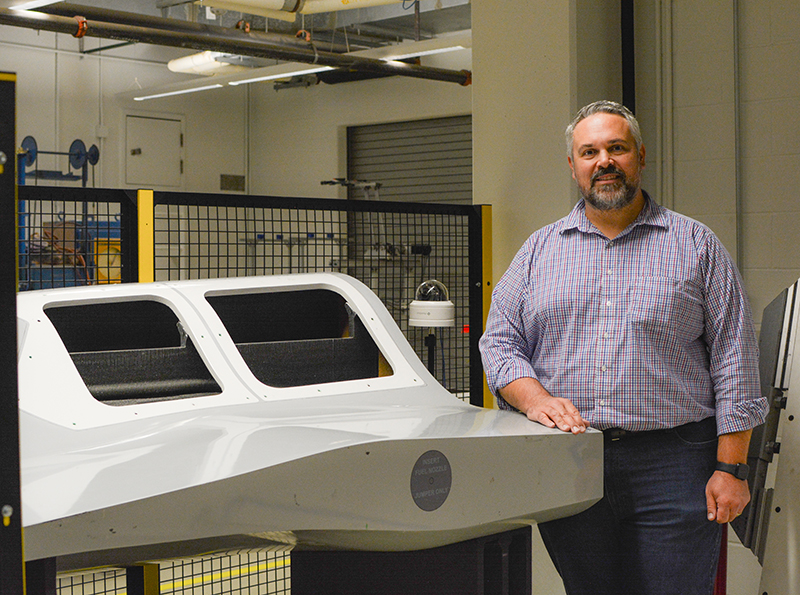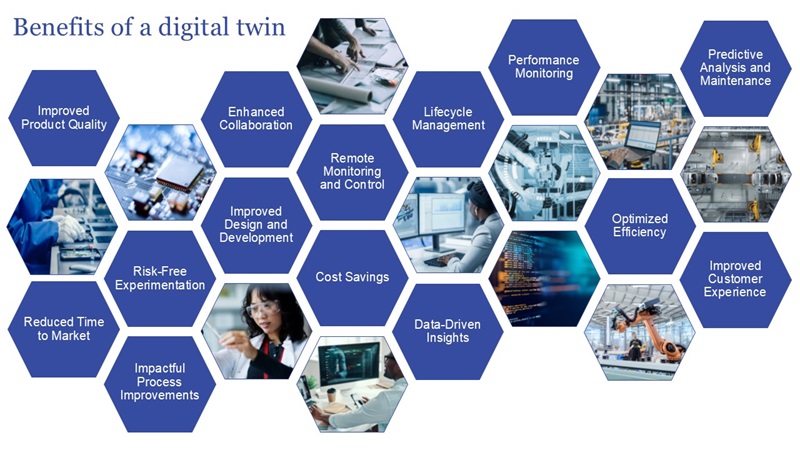What is a Digital Twin?
SMU Lyle’s new Center for Digital and Human-Augmented Manufacturing explores how digital twin technology will shape the future of manufacturing – but what is it, how does it work, and what are the benefits?

Imagine if you could create a digital copy of yourself. The virtual replica – or digital twin – would be like you in every way, except with a superpower: any mistakes you make would have no real-life impact. You could simply study the consequences and learn from them.
Decision making in your life would suddenly become a whole lot easier.
Now imagine owning a business and applying that same concept to your operations. You could run simulations, better understand and optimize processes, and make predictions about the future – all in a risk-free environment. Add artificial intelligence (AI) and machine learning into the equation, and now your digital twin can be fed real-time data and transform into a living, dynamic model that helps you infinitely improve.
This is the power of a digital twin, or more simply stated, a virtual replica of a real-world object, system, or process that can evolve in real time through data. While not a brand-new concept, digital twins are quickly gaining traction and becoming more powerful though increased sophistication in AI. Seventy percent of C-suite technology executives at large enterprises are already exploring and investing in digital twins to drive more agile business operations.
“The future of manufacturing is digital connectedness and moving toward total automation – that’s where the digital twin comes in,” said Chris Colaw, the Co-Executive Director of SMU Lyle’s new Center for Digital and Human-Augmented Manufacturing and Associate Professor of Practice in Mechanical Engineering. “You can gain a competitive edge in industry by integrating digital technologies that reduce costs, improve efficiencies, optimize workflows and give you enhanced insight into your manufacturing processes through sensors and data.”
Learn more about SMU Lyle's new Center for Digital and Human-Augmented Manufacturing
Colaw – an SMU Lyle alum – has spent his career at Lockheed Martin exploring how digital transformation and automation can revolutionize manufacturing. His efforts have culminated in more than $200M in cost savings for the company and improved safety and efficiency.
At SMU Lyle, Colaw is now helping students, researchers and industry professionals better understand how to harness digitalization and data-driven decision-making for the future of manufacturing. SMU is uniquely positioned to support this research through its NVIDIA DGX SuperPOD™ that provides high-performance AI supercomputing power.
Chris Colaw with a 3D-printed fighter plane model and AI camera in the Center for Digital and Human-Augmented Manufacturing
“Pushing the limits of Industry 4.0 capabilities and showing the world how you can integrate these technologies is a valuable skill, especially for an emerging workforce of future-ready, resilient engineers at SMU Lyle,” Colaw said.
What is a digital twin, and how does it work?
Digital twins are not like traditional, static 3D models. They’re continuously learning, updating, and optimizing through data from the real-world object, system, or process they’re “twinning” with.
The real-world object is outfitted with sensors that produce data, which is applied to the digital twin. The digital model then can be used to conduct simulations, predict problems before they happen, explore new opportunities, and plan for the future. Users can interact with the digital model through augmented and virtual reality.
For example, SMU Lyle’s Mustang Rocketry Club used digital twin technology to project the trajectory of their rocket in the Spaceport America Cup rocket engineering competition. Alexander Brandt, Ph.D. student in Mechanical Engineering, created Mustang Rocketry’s digital twin using a computer-aided design model that could be visualized to scale with virtual and augmented reality, along with simulation software regarding the rocket's kinetics and kinematics.
“It’s more than just a simulation,” Brandt said. “It allows us to accurately represent something in the physical world and know cohesively that this rocket is going to do what we think it’s going to do. I have the data from the first launch that I can now bring back to the digital twin and update to continuously improve the model with subsequent launches.”
Colaw is also researching how to digitize human-based inspection of aircraft. Typically, a mechanic would check every crevice for foreign objects or defects with an inspector following behind. With digital twin technology, workers could be alerted immediately when an AI camera detects a foreign object or defect, and the virtual model would indicate its exact location.
“You need to-the-millimeter precision on the location of aircraft defects,” Colaw said. “That’s where the digital twin comes in. You can also simulate how a foreign object migrated into the aircraft. Objects that should not be there can have serious consequences – like blocking a fuel filter and causing a crash.”
Digital twin benefits
The possibilities for digital twin technology are vast and exciting, including:
- Monitoring equipment: tracking performance and predicting failures before they happen
- Designing products: testing product designs in a virtual environment before production
- Personalizing medicine: developing individualized treatments and predict outcomes
- Managing infrastructure: maintaining roads, bridges, and utilities
- Optimizing the energy grid: simulating natural disasters and predicting loads and failures
- Testing vehicle designs: evaluating performance virtually before manufacturing
- Creating virtual classrooms: developing digital environments for immersive learning
“We’re excited to bring digital twin research to SMU and the Dallas area through our Center for Digital and Human-Augmented Manufacturing,” said Adel Alaeddini, Ph.D., the center’s Executive Director of Research Innovation and professor of Mechanical Engineering at SMU Lyle. “Engineers in our future workforce will need to think and work much differently than they do today, integrating AI and machine learning with traditional mechanical engineering. Our center will provide a space to explore the possibilities.”
About the Bobby Lyle School of Engineering
SMU's Lyle School of Engineering thrives on innovation that transcends traditional boundaries. We strongly believe in the power of externally funded, industry-supported research to drive progress and provide exceptional students with valuable industry insights. Our mission is to lead the way in digital transformation within engineering education, all while ensuring that every student graduates as a confident leader. Founded in 1925, SMU Lyle is one of the oldest engineering schools in the Southwest, offering undergraduate and graduate programs, including master’s and doctoral degrees.
About SMU
SMU is the nationally ranked global research university in the dynamic city of Dallas. SMU’s alumni, faculty and nearly 12,000 students in eight degree-granting schools demonstrate an entrepreneurial spirit as they lead change in their professions, community and the world.

